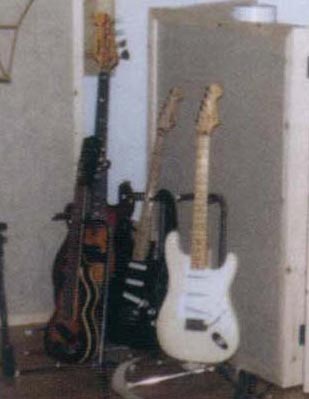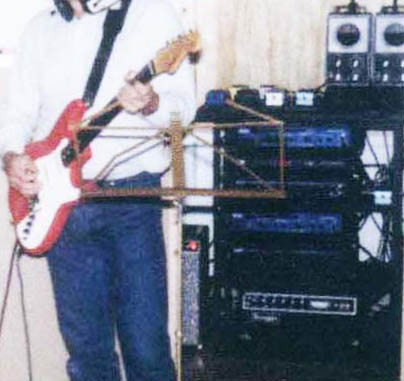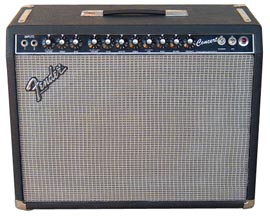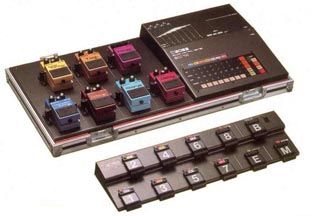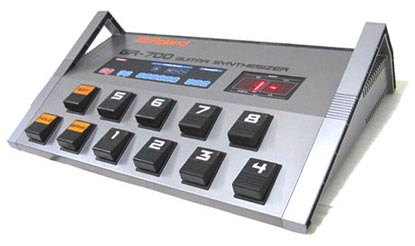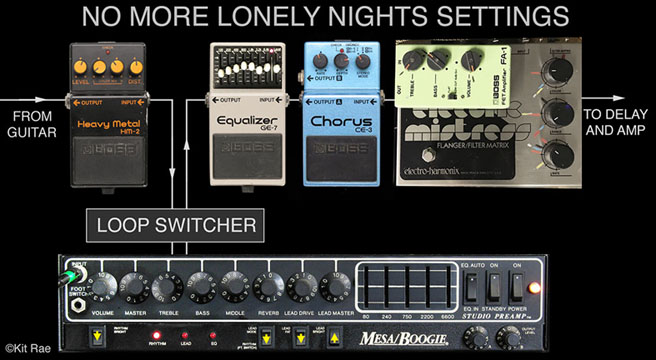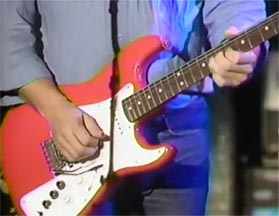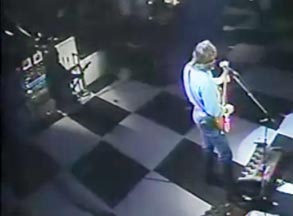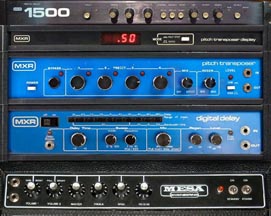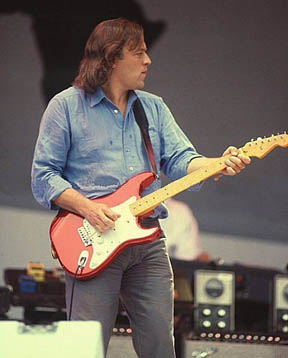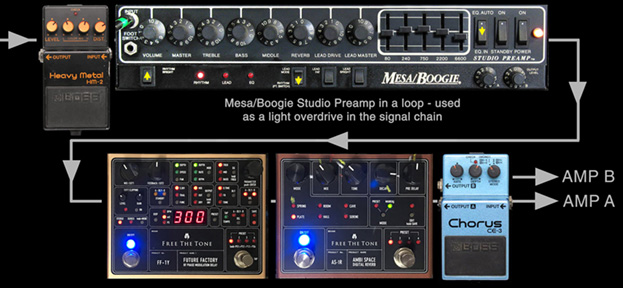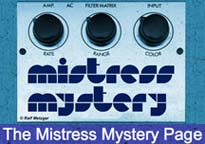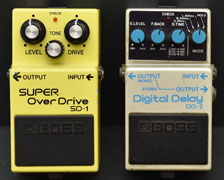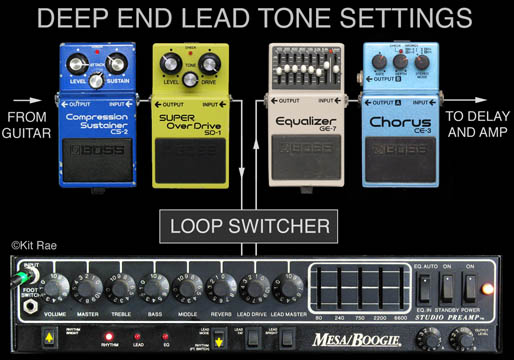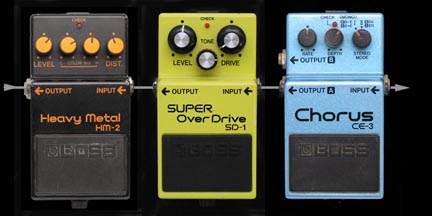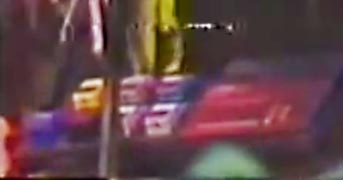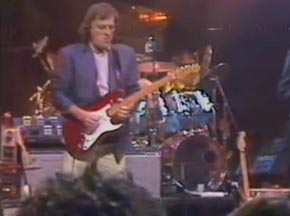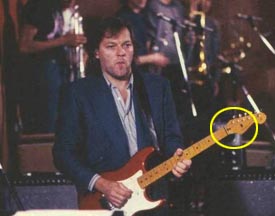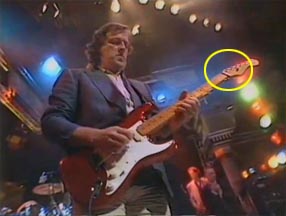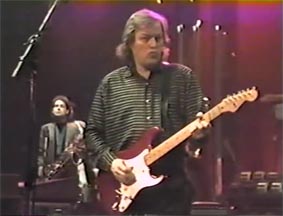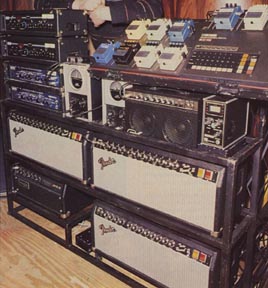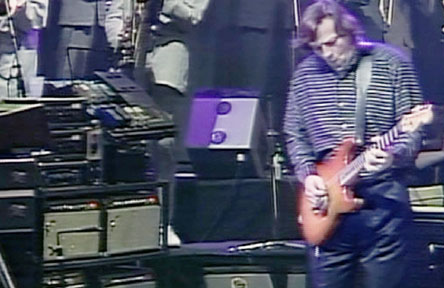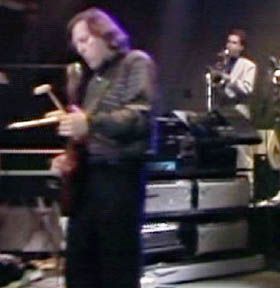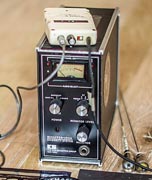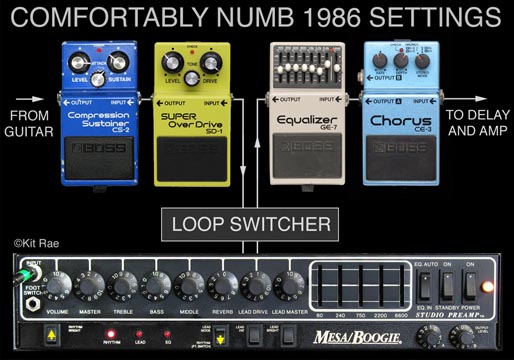NOTE: This website is frequently updated. Last update March 2024
WHAT DETERMINES WHETHER YOU WILL PLAY A SESSION? "Either because I like the artist or I think I might learn something, or they're friends of mine."- David Gilmour from Q Magazine, September 1990
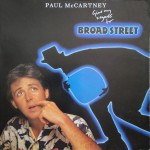
THE SESSION RIG 1984 / NO MORE LONELY NIGHTS - For David's session work during this period he used a stripped down version of his live rig, which included a stereo setup of two 1983 Fender Concert combo amplifiers with the Boss pedal board and rack effects positioned in between them. The Fender Concert was one of the fantastic amps from Paul River era of Fender designs. Basically it was a Fender blackface amp with some modern updates, and both a beautiful sounding clean channel and gain channel. It was a 60w, 2 channel amp with switchable channels, a bright push-pull on clean channel, mid-boost push-pull on gain channel, tube buffered effects loop, send/return level controls, line level output, and a 12" speaker. It offered many of the features you would find on a high end Mesa/Boogie amsp at teh time. The gain channel sounded a bit like an early Mesa/Boogie style overdrive, but really had its own sound. The Concert was one of the last hand wired amps to come from Fender.
Even with all those nice features, David was only using it for the clean channel, which sounded very similar to a black face Twin Reverb and took pedals very well.
Various versions of this rig were used for live gigs and recording sessions throughout the mid-to-late 1980s. One of the first times this rig was used was for Paul McCartney's Give My Regards to Broadstreet recording sessions in October 1984 for the song No More Lonely Nights. David's guitar work was one of the last tracks recorded. His guitars for the sessions were the Black Strat, the 57V reissue cream Strat used for the About Face tour, and the 57V candy apple red Strat. In session photos he is seen playing the fiesta red Fender 62V reissue Strat with the rosewood neck from the About Face tour, with some modifications. It was now fitted with an SCC-700 Roland guitar sythesizer pickup and controls.
I'm using the Roland unit at the moment; I've had it miniaturised and built into a Fender Stratocaster, so while I don't have all the controls that are on the Roland guitar, it's been simplified to just a volume control and a sensitivity switch. - David Gilmour interview by Bob Hewitt from Guitarist, June 1986
For the iconic No More Lonely Nights guitar solo, David used his 57V reissue candy apple red Strat, not the fiesta red 62V. It was fitted with the original stock single coil pickups and a shortened tremolo arm. It would later become his primary tour and recording guitar from 1988-2005 and be fitted with EMG-SA noiseless pickups and EXG/SPC controls. The 57V was played through the two Fender Concert amps in stereo, using a Boss CE-3 stereo chorus to split the channels. The A channel from the CE-3 was the wet chorus effect and the B channel was the same effect inverted. It could also be set with A wet and B dry. The solo sounds like David again used the Boss HM-2 + Mesa/Boogie combo, with some extreme EQ applied from a Boss GE-7. It is a very unique sound, and not easy to replicate. The modulation used has an Electric Mistress flanger quality to it, rather than the CE-3 chorus sound. I think David may have used a Mistress, or possibly blended the Mistress with the CE-3. David may have also blended a modulation effect from the Roland guitar synthesizer with the CE-3, as noted below.
Sessions rig for No More Lonely Nights in Paul McCartney's studio in October 1984.
(left photo) David's Black Strat and '57V reissue cream Strat
(right photo) 1983 Fender Concert combo amplifier (Phil Taylor states there were two used in the rig)
(midle photos) Pedal board with Boss effect pedals: Boss SD-1, Boss GE-7, Boss CS-2, Boss HM-2, Boss DD-2, Boss CE-3
Rack - top to bottom:
MXR 113 Digital Delay (to amp #1)
MXR Pitch Transposer Display
MXR Pitch Transposer
MXR 113 Digital Delay (to amp #2)
MXR 151 Digital Delay System II
Mesa/Boogie Mark I amp head

(left) Boss SCC-700B pedal board and sound control center and (right) SCC-700C programmable foot controller. This programmable switching system was one of the first on the market in 1982. It allowed up to 7 Boss effects to be used in any order with 32 programmable presets. (right) The Roland GR-700 Guitar Synthesizer pedal board from 1984. This was one of the first guitar synthesizers on the market.
The rig included David's Boss SCC-700 foot switcher and pedal board system from the About Face tour. David also added a Roland GR-700 guitar synthesizer/pedal board to this rig. The GR-700 was an early attempt by Roland at making a guitar synth, but the tracking was not very good and the MIDI function was erratic. It was strange seeing it in his rig, because a little over a year earlier he had this to say about it.
"I've tried out the Roland one a couple of times but it hasn't really particularly interested me. The synthesizer section on a Roland guitar synth is rather pathetic, and no one seems to have really made something like a Prophet or one of those keyboard synthesizers that has got a lot of stuff on it, and have that hooked up to a guitar. There's no difficulty in doing it really. One day I expect..." - David Gilmour in Guitar Heroes, May 1983
"The main fault on the Roland guitar synth for me, is that the MIDI output doesn't have bend on it - which seems crazy. If you plug it into a DX7 for instance, and use the tremolo arm, it goes up and down in semi-tones - and that is awful!" - David Gilmour interview by Bob Hewitt from Guitarist, June 1986
So how did David used the synth? According to what he said in Guitarist magazine in early 1986, the main effects rig and the synth feed were on two separate lines. He would blend in some of the synth signal into the main signal with a volume pedal. Latency caused a slight lag between the time a note was played and the time synthesized signal was heard (a limitation of the technology). When David blended in that latent signal with his direct signal, it created a flange effect. This may be the flange effect heard in the No More Lonely Nights solo.
The effects used with David's SCC-700 were the same as the 1984 tour - a Boss CS-2 compressor, Boss SD-1 Overdrive, Boss HM-2 Heavy Metal, Boss GE-7 Equalizer, Mesa Boogie Mark 1 amp head (used as an overdrive with the HM-2), Boss DD-2 Digital Delay, MXR Pitch Transposer and Pitch Transposer Display, MXR 113 Digital Delay, and MXR 151 Digital Delay System II, into a Boss CE-3 stereo chorus. The stereo chorus was sent to two identical amplifiers on the left and right for stereo. Sometimes David would use four Fender combo amps, two for left and two for right.
GETTING THE TONE - I have experimented for many years to find the exact setup David used for the fantastic guitar tone in No More Lonely Nights. I have gotten close, but have never replicated that exact boxy tone successfully. There are several combinations that work, but the closest I have gotten is this setup: Strat with EMG-SA pickups and SPC set high, Boss HM-2 into a Mesa/Boogie Mark III amp head (used as a slightly dirty overdrive in the signal chain) set for light overdrive using the lead channel, Boss GE-7 equalizer set with a mids boost and bass/treble cut, Electro-Harmonix Electric Mistress, Boss CE-3 chorus, Boss DD-2 digital delay set for 520ms, into a Fender Twin Reverb. Settings are shown below.
Below is a stereo clip using the settings shown above. The signal is split using the stero outputs of the CE-3 into a Twin reverb (left) and 59 Bassman (right)
![]() No More Lonely Nights solo - Boss HM-2, stereo
No More Lonely Nights solo - Boss HM-2, stereo
Below is a stereo clip using the same setup as above, but using a Ram's Head Big Muff instead of the HM-2.
![]() No More Lonely Nights solo - Ram's Head Big Muff, stereo
No More Lonely Nights solo - Ram's Head Big Muff, stereo
Below is a clip using the same setup as the HM-2 clip, but without the Electric Mistress, and only going to the Fender Twin Reverb in mono.
![]() No More Lonely Nights solo - Boss HM-2, mono
No More Lonely Nights solo - Boss HM-2, mono
GUITAR GREATS CONCERT 1984 - David used this same session rig and his '62V reissue Stratocaster from the No More Lonely Nights session a month later for the Guitar Greats concert performed in the Capitol Theater, New Jersey, on November 30th, 1984. David performed You Know I'm Right and Murder, as well as two other songs with all of the guest guitarists cramming the stage. It aired on MTV in February 1985. An MXR M-190 1500ms digital delay was added to the rack, replacing the MXR Delay System II, but otherwise the effects remained basically the same as the Lonely Nights rig above. This time David used two Silverface Fender Twin Reverbs on top of the two 1983 Fender Concert amplifier combos, which sounded like black face Twin Reverbs. The sound was very much like his About Face tour. David again had the Roland GR-700 guitar synthesizer/pedal board, but it is unknown if he used it. There was is a pitch/harmonizer effect used on Murder, but it sounded the same as the MXR Pitch Transposer used on the 1984 tour for Until We Sleep. The lead tone sounded like the Boss HM-2 + Mesa/Boogie and Boss CE-3.
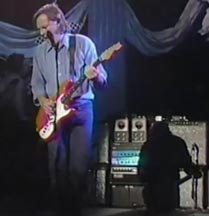
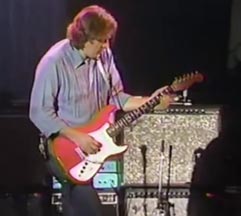
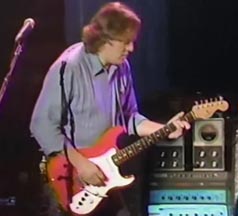
Top stack L and R: Fender Silverface Twin Reverb combos
Bottom stack L and R: 1983 Fender Concert combos
Pedal Board with Boss effect pedals: Boss SD-1, Boss GE-7, Boss CS-2, Boss HM-2, Boss DD-2, Boss CE-3
Rack - top to bottom:
MXR M-190 1500ms Digital Delay (Digital Delay, Hold, Flange, Double, Echo)
MXR Pitch Transposer Display
MXR Pitch Transposer
MXR 113 Digital Delay
Mesa/Boogie Mark I amp head
BOYS AND GIRLS (1985) Session with Bryan Ferry for his sixth solo album. - Gilmour had been friends with Bryan Ferry and Phil Manzanera of Roxy Music for a long time and has worked with each on several projects over the years. Sometime late 1984 or early 1985 Gilmour played guitar in sessions for Ferry's Boys and Girls album, released in June 1985. There were many guitarists who played in these sesions and most of the work is clearly not David. The album only has a general performer credits, not specific to any songs, so it is unlcear which tracks David plays on, but he is definitely playing the guitar solo in Sensation, the triplet time delayed guitar and some of the lead fills in Boys and Girls, and possibly the atmospheric guitar coloring in the background of Chosen One. David is often credited with the solos on Slave to Love, but those were actually played by Keith Scott and Neil Hubbard.
![]() Gilmour Guitar excerpts from Sensation and Boys and Girls
Gilmour Guitar excerpts from Sensation and Boys and Girls
The echo repeats in the Sensation solo have a flanged/phased effect. This may be the effect from the GR700 guitar synthesizer that David described in Guitarist magazine after the sessions were complete.
"I have the synth going through a DDL and a chorus, and I also have a volume pedal for it. In fact, I have had the guitar synth volume pedals altered, so I can use them side by side, controlling them individually or both at the same time with just my right foot. The guitar synth is a little slow to react, so I tuck it in just behind the guitar level. Now,when you bend or use the tremolo arm the one follows the other down and you get this flanging sound. That's an accidental benefit and it sounds great!!" - David Gilmour interview by Bob Hewitt from Guitarist, June 1986
LIVE AID CONCERT AND FIRST APPEARANCE OF THE V57 RED EMG STRAT IN 1985 - A modified version of the rig was used on July 13th, 1985 when Gilmour played a set of songs with Bryan Ferry's band for the Live Aid benefit concert in London's Wembley Stadium. Keyboardist/guitarist Jon Carin was a member of Bryan Ferry's backing band at this time, and he would later work extensively with Pink Floyd in that same period. David can be heard on Slave to Love and John Lennon's Jealous Guy. He used four Fender Concert combo amplifiers stacked on top of four Fender speaker cabinets. The lower cabs do not appear to be mic'd. As sated above, the clean channel of the Concerts sounded very much like a black face Twin Reverb. The Boss SCC-700 pedal board system and Boss pedals were again used - Boss CS-2 compressor, Boss SD-1 Super Overdrive, Boss HM-2 Heavy Metal, Boss GE-7 Equalizer, Boss DD-2, and Boss CE-3. He also used the Roland GR700 guitar synthesizer pedal board, but it appears only a few rack effects were in the rig. It difficult to see the Mesa/Boogie amp head in this rig, but I assume it was also used.
Gilmour's first stage use of his candy apple red 57V reissue Stratocaster, purchased in January 1984. It was fitted with EMG-SA pickups and EXG/SPC controls in place of the tone knobs
David started the first song with his sunburst 57V Strat (purchased in January 1984) that just had a new 5 way pickup selector installed when it stopped working. David immediately switched to a backup guitar, a Candy Apple Red 57V Stratocaster reissue. It would become his primary stage guitar for the next 20 years. It was fitted with EMG-SA noiseless pickups, EXG/SPC controls replaced the tone controls, and the tremolo arm was shortened so it fit in David's palm while he played.
"The Candy Apple Red Strat is one that I bought from Fender here in England. I went to their warehouse - you know, you can just pick up a guitar without plugging it into an amp - and I went through about 20 of their guitars. I was about to head out on tour and I wanted a couple of guitars and a couple of spares for it, so I think I bought about four. And I literally just picked them up and played them, and that was one of them."
"Because of the problems with the electronics of being on tour, if you have a big lighting rig, all those dimmers tend to make your guitar equipment hum and buzz rather violently and sometimes it's almost impossible to play. So EMG made pickups which were low impedance, battery operated pickups that I had installed in that guitar. They are very, very good pickups, they sound great, and you get no problems with buzz and hum. I played it all the way through the A Momentary Lapse Of Reason album tour and The Division Bell album and tour."- David Gilmour in 2019
"They also have tonal circuitry which can boost the thickness of the guitar’s sound. When you’re playing solos the high notes can sometimes get a bit thin on a regular Strat and this guitar had a solution for that and it became my go to guitar for quite a while. This guitar has served me very well."- David Gilmour in 2019
David acquired this guitar in early 1984. It was one of several (reportedly 4 - 6) new 57V Strats from Fender's vintage reissue series purchased for his About Face tour from the CBS Fender UK warehouse in Enfield, Middlesex. The first batch of guitars David hand selected included his '57V cream Strat, a fiesta red 62V Strat, amd a Stratocaster Elite. All of them had the same set of mods done to them - shortened tremolo arms, EMG-SA pickups, and SPC/EXG controls installed. The second batch of guitars David hand selected included this 57 reissue Strat, and Live Aid was the first major appearance of it being used. It was then used extensively on stage from 1986-1990, was his primary guitar for the 1994 Pink Floyd tour, many guest appearances thereafter, and was his primary recording guitar from 1988-2005, including his solo album On An Island.
![]() Gilmour Guitar Solos from Live Aid
Gilmour Guitar Solos from Live Aid
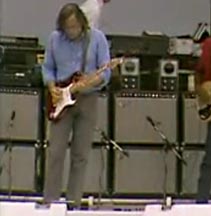
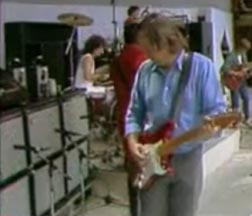
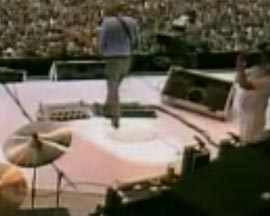
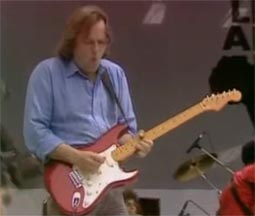
David used his Boss SCC-700 pedal board system with Boss CS-2 compressor, Boss SD-1 Overdrive, Boss HM-2 Heavy Metal, Boss GE-7 Equalizer, Boss DD-2, and Boss CE-3
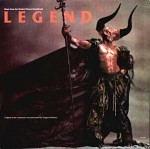
IS YOUR LOVE STRONG ENOUGH? (1985) - Session with Bryan Ferry for the Legend movie soundtrack. I was a fan of both director Ridley Scott and Tangerine Dream, so I saw Legend in the theater and bought the Tangerine Dream movie soundtrack, which included this song that played over the end credits. I was not aware David played on Is Your Love Strong Enough? before hearing it, but when I first heard it on the radio before seeing the film, I recognized that it was David playing before it got to the guitar solo. From the beginning and throughout the song there are beautiful, ambient volume swells awash in delay from David's guitar, in addition to the lengthy guitar solo. He used a volume pedal and a digital delay with a long delay time for the volume swells. The solo sounds like the Boss HM-2 + Boss SD-1 combo described above for the Deep End concerts in 1985, only with more delay.
This song, originally called Circles, was a left over from Roxy Music's Avalon album. Bryan Ferry was asked to contribute a song to the American version of Ridley Scott's movie Legend, so this song was dusted off and recorded with Gilmour, who also appears in the music video mime-playing his serial number 0001 white Strat, which is presumably what he played in the recording sessions.
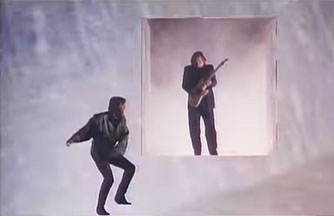
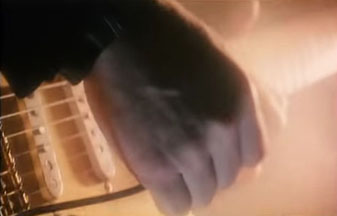
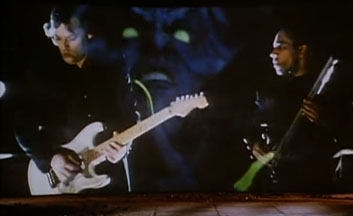
Gilmour playing his serial #0001 white Strat in the video for Is Your Love Strong Enough
There are three versions of the song, a video version with a longer intro that includes more of Gilmour's volume swells on the guitar, the album version with a shorter intro, and an extended 7:15 minute version with a longer guitar solo released as B-Side from a 12" 33 1/2 RPM vinyl single and on the Maxi CD Dance with Life. Below is the longer solo from the extended version.
![]() Is Your Love Strong Enough_extended solo
Is Your Love Strong Enough_extended solo
GETTING THE TONE - Similar to the Deep End setup (described above). Run a Boss HM-2 before a Boss SD-1 Super Overdrive (with the SD-1 Drive dialed off and the Tone set around 1:30), a digital delay, Boss chorus like the CE-2 or CE-3, into a Fender Twin Reverb or other clean sounding Fender amp. Another way to get a similar tone is to use ProCo Rat in place of the HM-2 and SD-1. It sounds best to me with a Strat loaded with EMG pickups and the SPC control on maximum, but regular single coil Strat pickups work too.
For the solo leads, use a 640ms digital delay, with long repeats. Use the bridge pickup on a Strat and play with a deep tremolo from the whammy bar, in time with the song. To create the volume swells, use a volume pedal before the delay in the signal chain. Pick the note, then fade the volume up and let the echo repeats sustain the note before bringing the volume back down.
I hear two different delay times on the volume swells. Some are set at 370ms and some are set at 640ms, with long repeats. There is a variety of things David is doing with the volume swells to create the atmosphere of the song - fading in while using the tremolo bar heavily, bending a note up then fading in on the down bend, fading in while adding tremolo to a note and dropping the whammy bard down on the fade out, fading in after picking a pinch harmonic and bending the notte. Below is an example of those tchniques.
![]() Is Your Love Strong Enough volume swells on guitar
Is Your Love Strong Enough volume swells on guitar
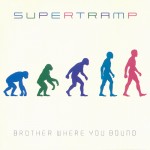
BROTHER WHERE YOU BOUND (1985) Supertramp Session - One of the first times I ever heard David Gilmour do a guest solo with another band was on the Supertramp song Brother Where You Bound, from the album of the same name. David's playing is very fiery and intense, and probably the best thing about this long title track. David only played on this one song, but he plays parts throughout, plays the middle solo, and the outro solo. The setup sounds like another variation of his Boss HM-2 + Mesa/Boogie into a Fender setup.
Supertramp drummer Bob Seibenberg, about the the spur-of-the-moment idea of using David Gilmour to guest solo on Brother Where You Bound? "We were sort of going, ‘Well, a Dave Gilmour-kinda thing would be neat here'...Norman our engineer went, ‘Well why the…don’t you just call up Dave Gilmour?!’...So we sent him a cassette, and he came back to us in a couple of days and said, ‘When?’ And he was just great to work with. I mean you don’t have to do anything at the desk. He works out there with his roadie for a couple of hours, and fiddles with all his stuff, and it’s like ‘Ready!’ You just slip the fader up and it’s just there – like a trademark sound.” - from an interview by Steve Newton from Georgia Straight Newspaper, June 28, 1985
GETTING THE TONE - Below is an example of David's Boss HM-2+ Mesa Boogie tone, in stereo through two combo amps. This is a Strat with a Seymour Duncan SSL-5 bridge pickup. The signal chain is HM-2 > Mesa/Boogie Studio Preamp set for overdrive > FTT Future Factory delay (300 ms) > FTT Ambi Space plate reverb > Boss CE-3 chorus using the A and B outputs to two different amps - 59 Fender Bassman (left channel) and Fender Twin Reverb (right channel). You can also add a compressor like a Boss CS-2 or CS-3 before the HM-2 to give it a bit more punch if needed.
This is the signal chain and settings I use for the middle solo sound
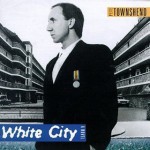
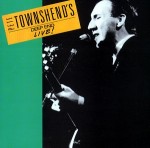
"Among players — particularly among British players — he's incredibly highly rated — adored, I'd say. And he has a way of putting incredible feeling into everything that he does. I suppose technically, he's very good. But that's not the important thing. The important thing is the way that he plays." - Pete Townshend
"Dave was fabulous, beautiful player. One thing you find out when you do play with Olympian Rock Colossi (Gilmour and Townshend), as I used to call them, is that, yes, they are very established and you know what they do, but you don’t really know how good they are as a player. It’s only when you play with them that you find out an awful lot…I was stunned by the way that Dave played. What a beautiful player. I didn’t realize…It’s the touch and the sound. That’s what makes them. That’s what really differentiates the masters from the not-so-masters" - Simon Phillips, RS 2021
DEEP END CONCERTS 1985/1986 - David Gilmour played guitar on Pete Townshend's White City album and in his short lived Deep End band in October and November 1985. The band was billed as "Pete Townshend with David Gilmour and Deep End", and only performed a few concerts and on a few television shows. Two concerts were recorded and released as the Deep End Live! album and VHS video in 1986. Townshend put the Deep End band together again in January 1986 for a final performance at Midem, in Cannes, France that aired on the German TV series Rockpalast. It was released on DVD in 2016. For the 1985 performances David usually played his Candy Apple Red '57V Stratocaster reissue, fitted with EMG-SA pickups and EXG/SPC controls. For the 1986 performance he mostly played a custom flame top Charvel San Dimas with a single EMG-H pickup and SPC control.
I was obsessed with replicating David's lead tone with a Boss HM-2 at the time, without much success. That's because I later found that David was using the Boss SD-1 Super Overdrive for the leads here, not the HM-2. Or more specifically, I think the SD-1 was combined with a Mesa Boogie head (used an an overdrive in the signal chain, not powering speakers), then into the Boss CE-3 chorus and delay. His rig was an expanded version of the one used for the Guitar Greats and Live Aid concerts, including the Boss SCC-700 pedal board system, Boss pedals, and Fender Concert combo amps.
The SD-1 Super Overdrive is an iconic overdrive, with a tone circuit similar to the Ibanez Tube Screamer. Sonically the SD-1 is in the same tone family as the TS, but it has a bit more low end and a bit more dirt in the distortion. Interestingly, this SD-1/Mesa Boogie tone is very reminiscent of the Fuzz Face tone from David's solo in the Pink Floyd song Biding My Time, recorded way back in 1969! David probably used a cocked wah wah pedal to EQ his Fuzz Face back then to create this tone.
![]() Gilmour Guitar Solo excerpt from Pink Floyd's Biding My Time - 1969
Gilmour Guitar Solo excerpt from Pink Floyd's Biding My Time - 1969
![]() Gilmour Guitar Solos from Pete Towshend's 1985 Deep End Concerts
Gilmour Guitar Solos from Pete Towshend's 1985 Deep End Concerts
GETTING THE TONE - One of the stand out tracks from these concerts was the song Give Blood, with some of David's signature "triplet-time" delay playing by David, or as Pete Townshend called it, "ricky-ticky-ricky-ticky things". For overdrive, I believe David used his Boss SD-1 with the drive set around 50%. He also probably used the CS-2 compressor in front of that to give it a bit more punch. For delay, I believe David used his Boss DD-2 digital delays set for 360ms, delay volume maximum, with about 6-7 repeats.
SD-1 and DD-2 settings for Give Blood
Below is a clip of that signal chain, using a Strat with EMG-SA pickups into Reeves Custom 50. Luckily, one of the live Deep End perfomances only had David's guitar mixed in one channel, so I was able to make a rough backing track to play over using the other channel for both the L and R.
![]() Give Blood - Boss CS-2, Boss SD-1, and Boss DD-2
Give Blood - Boss CS-2, Boss SD-1, and Boss DD-2
Below is a video lesson on how to play the main parts of the song. I used a stereo setup this time. I used two DD-2 delays, one for each amp. Reeves Custom 50 (right) and 59 Bassman (left). A Boss CE-2 chorus is going to one amp.
David's lead tone for the 1985 performances sounded like he primarily used the Boss SD-1 Super Overdrive (drive and tone at maximum) into the Mesa Boogie head (set for a slightly dirty tone), although it may have been the other way around. The Boss CE-3 was used for the heavy chorus effect, a digital delay was set around 420-440ms, into a Twin Reverb. A Boss GE-7 EQ was likely used to fine tune the tone, but I find it is not really necessary. My settings to get this tone are below. I use a Mesa/Boogie Studio Preamp in place of the Mark I David used in his rig. It was based on the Mark IIC design, has similar controls as the IIC/C+, and the clean channel sounds like an early 1970s Fender blackface (or early silverface) amp, like the Mark I. I set it for a clean tone, with some light drive. If you do this, place the Boogie in a loop switcher between the distortion/drive pedals and the chorus/delays, so you can switch it on and off like an overdrive pedal. It sounds best with a Strat loaded with EMG pickups and the SPC control on maximum.
Another possible setup that works is a blend of the Boss HM-2 + SD-1 Super Overdrive. Run the Boss HM-2 before the Boss SD-1 , with the SD-1 Drive dialed off and the Tone set around 3:00. The SD-1 has a very bright mid range, and running it after the HM-2 acts as a mid range EQ for the HM-2 tone, creating the same smooth, fuzzy overdrive tone heard in the concerts. The latter is likely what David used. I have also tried using a TS-9 Tube Screamer with the HM-2, and it does work as a substitute, but it does not blend with the HM-2 quite as well as the SD-1. Another way to get a similar tone is to use ProCo Rat in place of the HM-2 and SD-1. For delay, use a digital delay setting around 420-440ms. For amps, use a clean Fender amp like a Twin Reverb or similar.
Boss HM-2, SD-1, and CE-3 settings for the Deep End lead tone
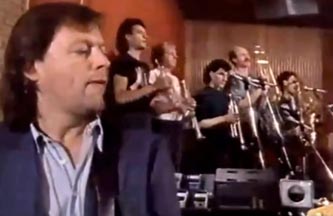
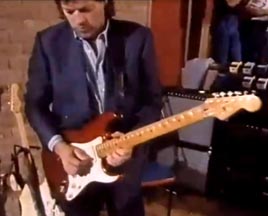
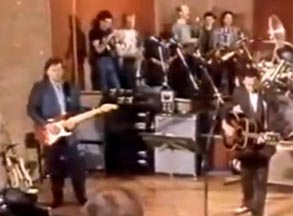
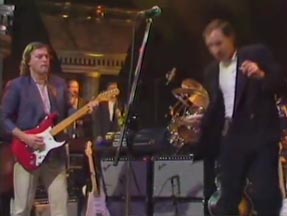
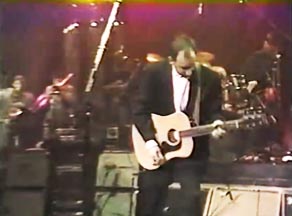

Pete Townshend's Deep End band with David Gilmour performing in October and November 1985, shown above. David's rig again consisted of a Boss pedal system, MXR rack effects, a Mesa/Boogie amp head, and Fender Concert combo amps. The Boss effect pedals seem to be the same as the 1984 tour: Boss CS-2, Boss SD-1, Boss HM-2, Boss GE-7, two Boss DD-2s, and a Boss CE-3 stereo chorus.
Unhappy with the Kahler tremolo system on his Black Strat, David had a Dive Bomber Tremolo Upgrade system added to his Candy Apple Red '57 Strat reissue, shown above. "Dive Bombing" is what dropping the tremolo arm all the way down was called, and many players had issues with the Strats going out of tune. This kit included a graphite nut and graphite string trees, replacement saddles with roller nuts (so the strings would roll instead of binding in the saddles) and higher quality springs. This system was later deemed non effective and removed.
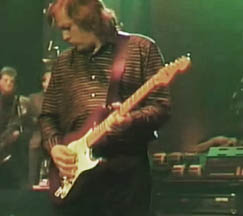
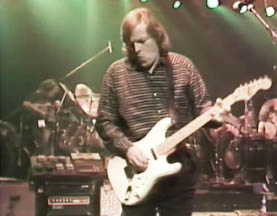
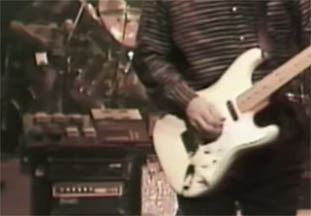
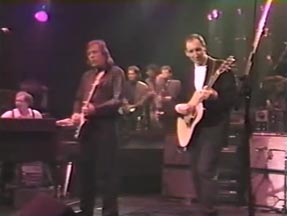
Pete Townshend's Deep End band with David Gilmour performing in 1985. David's rig consisted of a Boss pedal system, MXR rack effects, a Mesa/Boogie amp head, and Fender Concert Combo Amps. He played his CandyApple Red '57 Strat reissue and his cream colored '57 reissue with black pickup covers.
By 1986 David had finished most of his session and live work with Bryan Ferry, Pete Townshend, and others, including producing an album for Dream Academy. He was about to begin work on the next Pink Floyd album, but Pete Townshend had booked one final performance for Deep End in January 1986 at MIDEM, in Cannes, France, David used a slightly different rig as the previous Deep End shows and his sound was slightly different. He changed from Fender Concert Combo amps to Fender Twin Reverb II heads and added a small Gallien-Krueger 250ML amp to the rig. He played a lovely flame top Charvel San Dimas Strat-styled guitar for almost all of the show. He also again played his CandyApple Red '57V Strat reissue and what appeared to be his cream colored '57V reissue. The white pickup covers it had in 1984 were changed to black. After this last Deep End show an extra CE-3 chorus and GE-7 EQ were added for his Boss SCC-700 guitar sythesizer.
David's rig as it appeared in early 1986. The stereo rig consisted of a Boss pedal system, four MXR digital delay rack effects, a Mesa/Boogie amp head, a Gallien-Krueger 250ML amp, and two Fender Twin Reverb II amps powering a Marshall 4x 12 and a WEM 4 x 12 speaker cabinet. Boss effect pedals: Boss CS-2, Boss SD-1, Boss HM-2, Boss GE-7, two Boss DD-2s (one for each amp), and a Boss CE-3 stereo chorus.
DAVID'S 1986 RIG - David used Boss effect pedals and Fender amplification all throughout the 1984-86 period. Boss pedals were very hot in the market at this time and extremely reliable. The fact that original pedals from this era are still reliably used today is a testament to that fact. In 1986, the top selling pedals in the whole effects pedal industry were all Boss. The DD-2 Digital Delay was at the top, with the HM-2 Heavy Metal in the number three spot. David had each in this rig, but he used them a bit differently than most guitarists. The CE-2 chorus was the number #2 top selling pedal, but David continued to use the CE-3 for its stereo outputs, which worked better with his stereo rig. He also used a stereo delay setup. A DD-2 Digital Delay and MXR 113 Digital Delay were sent to one Fender amp and a matching pair were sent to the other amp.
His 1986 rig was similar to the 1985 version, but it had grown slightly, with a few changes. The main changes were the Fender Twin Reverb II amp heads and the addition of a Gallien-Krueger 250ML amp, which he would use extensively for recornding the new Pink Floyd tracks he was about to begin work on. David described the whole rig in detail in mid 1986.
"From the guitar I use a Radio Transmitter system - Shaeffer Vega - into a Roland/Boss pedalboard which is computerised. I go into a Mesa/Boogie head next, which I use as a sort of pre-amp for the loud and raunchy stuff and then I have a bunch of pedals - 4 DDL's - which I use in different combinations, MXR Digitals and the little Boss DD2's... From there we go into a Boss Chorus Stereo unit which splits into two Fender Twin Reverb 2 heads and they got to one Marshall and one WEM cabinet each. There is also a little Gallien-Krueger amp in there as well, which is very nice in the studio-they say it's very much like using a Rockman. I've used a Rockman in the studio, straight into the desk, but the Krueger is very handy. I just put it down here on the floor of the control room with this microphone, get a nice sound, record it, and worry about the EQ afterwards!" - David Gilmour interview by Bob Hewitt from Guitarist, June 1986
Something interesting I noticed in that interview was that David said the Mesa/Boogie was used as a preamp before the pedals. In 1984 he said he was using the Boogie after his Bos HM-2. The Boogie still had a dummy load placed on the speaker ourput so David could use it as an effect in his signal chain, but the signal chain order was changed in this version of the rig. Another interesting fact from the time was a change added to the Mesa/Boogie owners manual in 1986. Boogies were among the first amps to have Slave outputs and Effects Loop send/returns. The effects loop was added in 1981 and allowed the insertion of pedals and effects in between the preamp and power amp stages on the amplifier. The Slave output was a direct output of the whole amp signal, meant for direct connection to a mixing board or to another amplifier. David sent his pedal board signal to the amp input and used the Slave output jack to send it directly back to the board. In 1986 Mesa released the Boogie Mark III head and combo, as well as a rack mounted Mark III head, and the Mesa Boogie Studio Preamp. The Slave output was renamed the Direct output, and this line was added to the Mark III owners manual - "In some sophisticated set-ups, players run their Direct into their Effects Rack and then from the Effects into other, external amplifiers. Also note that a speaker or load resistor should be plugged into a Speaker jack when using the Direct." That is an exact description of what David was doing in 1984-85, so I suspect this owners manual change may have been inspired by his rig.
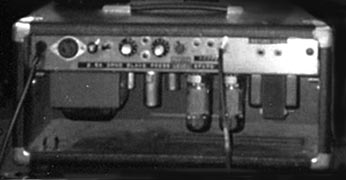
Back of a Mesa/Boogie Mark I showing the Slave output and Effects Loop Send/Return jacks
Another element of this rig that some people think contibuted to the tone shaping, although in a very minimal way, was the wireless radio transmitter David used. The Schaffer Vega Diversity System (SVDS), made from 1975-1981, was one of the first reliable wireless stage systems. It was used by many of the top touring musicians at the time, as well being a part of some recording studio rigs. Why use wireless system in a recording studio? Not for the wireless aspect of the SVDS, but for the slight, and unintentional, tone coloring created by the circuit when the signal was compressed in the transmitter then expanded at the receiver. This 'companding' circuit altered the harmonic content of the guitar signal in a way that some guitarists liked, as well as adding a clean boost. To my knowlwdge, David never used one in the studio like this, but he did use them in his live rigs from 1980-1990.
Gilmour's wireless guitar system, the Schaffer Vega Diversity System (SVDS)
Only around 1000 SVDS were made and Pink Floyd owned about 20 of them. David used them in his live rig for The Wall concerts and his 1984-86 live rig. Finding a functioning SVDS these days is extremely rare and expensive, but a company called SoloDallas made a replica of the SVDS (minus the wireless part of the circuit) in both tower and foot pedal forms. I don't know how accurate their replicas were to the original circuit, but I tried one of each around 2016. It was basically a clean boost that allowed a bit of drive to be dialed in. Both units were very noisy, so I could not really determine if there was any unique change to the tone when passing my signal through them. I think David only used it becasue it was one of the only reliable wireless systems available at the time, not for any tone altering benefit.
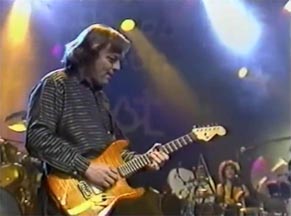
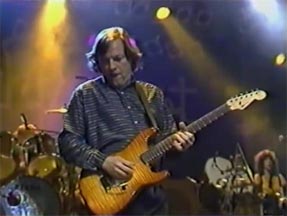
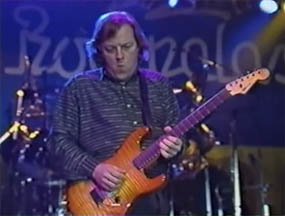
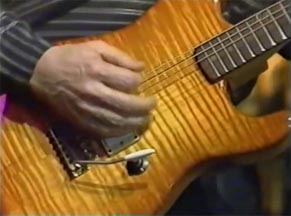
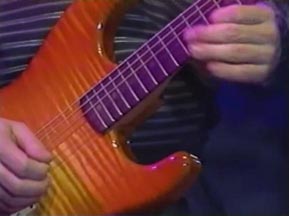
The Charvel San Dimas was used several times by David in 1986 and in Pink Floyd's Madison Square Garden concert in 1987. He bought the guitar at No1 Music Center in Hamburg, Germany during the About Face tour in 1984. It was an early 1980s model, hand-made in the San Dimas, California shop. It was given to No1 Music Center as a gift from Charvel, not intended for sale, but Gilmour was allowed to buy it. Grover Jackson made an arrangement to make a similar looking guitar for No1 to replace the one David bought. Phil Taylor replaced the humbucker pickup with an EMG active pickup and installed a dual SPC presence control / volume pot to replace the stock volume pot. According to Doug Marhoffer of EMG national sales, the pickup was an EMG-H model - a single coil EMG in a humbucker sized housing with a ceramic magnet, rather than the Alnico magnet like the EMG-SA pickups used in David's Strats. The difference is slightly less midrange than the SA model. David later used EMG-H pickups in his Jedson slide guitars in 1987.
COLUMBIAN VOLCANO APPEAL 1986 - On February 9th, 1986 David played four songs for the Columbian Volcano Appeal fund raising concert at the Royal Albert Hall in London. His band was made up of mostly Pete Townshend's Deep End band members, along with Mick Ralphs, who played rhythm guitar for David in 1984. He again used his Charvel San Dimas guitar with the EMG pickup and SPC control. David's rig was basically the same Deep End rig from January, with the Boss SCC-700 pedal board system, Boss pedals, MXR rack effects, Mesa/Boogie amp head (with dummy speaker load), and Fender Twin Reverb II amp heads in stereo. David's tone and performance of Comfortably Numb that night was one of his best, and a fan favorite from this period. It was very different from the 1984 tour tone.
![]() Comfortably Numb solo from February 9th, 1986
Comfortably Numb solo from February 9th, 1986
GETTING THE TONE - David's lead tone was similar to his 1985/1986 Deep End tone, described above, but with more mid range boost and a slightly fatter sound. The chorus effect was less dominating than in 1984, most likely because it was only going to one of the two Twin Reverbs. I think the core tone is the Boss SD-1 Super Overdrive. It was blended with the Mesa/Boogie into a Twin Reverb for the solos, the same as he was using for the Deep End concerts prior to this. The SD-1 sound is very simialr to a Tube Screamer, but is much better for Gilmour tones in this setting than a TS. Set the SD-1 Drive knob to maximum and the tone knob to around 4:00. The Mesa/Boogie overdrive can be set identically to the 1984 and Deep End settings. It can be placed before or after the SD-1 in the signal chain. The tone sounds a bit smoother before it and a bit grittier after.
Set the Rate on the CE-3 chorus to around 11:00 and the Depth to around 1:00. David may have also used his Boss CS-2 compressor, but it adds a lot of noise. For delay, David used a long echo repeat of 750ms, with 4-5 repeats. The delay volume was loud, making the whole solo sound huge.
You can also get close to the same tone with the Boss HM-2 in place of the SD-1 by dialing the Hi knob up to around 1:00, and the Lo to about 2:00, but the SD-1 sounds much closer when using a Twin Reverb. If you are using a Hiwatt, that setup above will sound very different. I have found that running a ProCo Rat into a Boss BD-2 Blues Driver, instead of the SD-1 into Mesa/Boogie, is the best way to achieve this tone on a Hiwatt. Another simple setup that works very well for me through a single Twin Reverb is running the SD-1 into a TC Electronic Booster+Line Driver with a light drive setting, and using a Boss CE-2-B chorus with the mix at 50%. Nothing else is needed other than delay.
This tone sounds best with a Strat style guitar loaded with EMG pickups and the SPC control set high. David used an EMG-H pickup in his Charvel, not a humbucker. The H was a single coil EMG in a humbucker sized housing with a ceramic magnet, rather than the Alnico magnet like the EMG-SA pickups used in David's Strats.
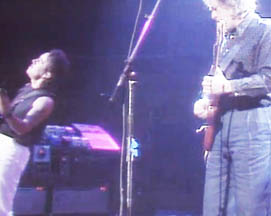
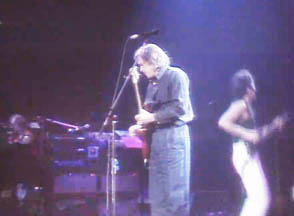
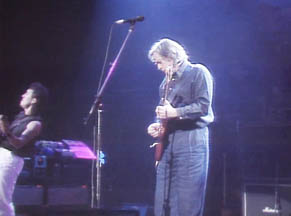
David's SCC-700 Boss pedal board and Boss effect pedals on top of the rack. Rack amps were a Mesa/Boogie head and three Fender Twin Reverb II heads.
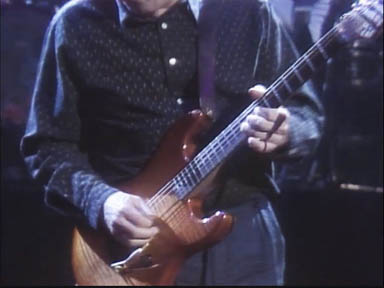
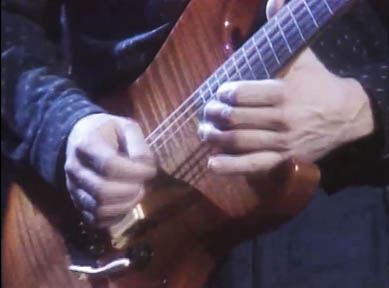
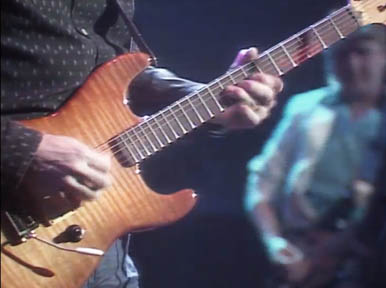
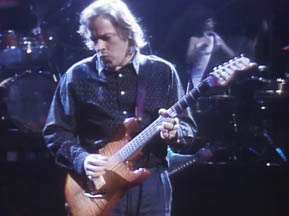
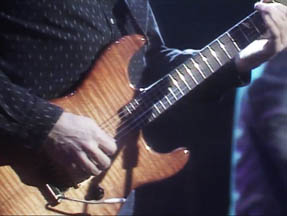
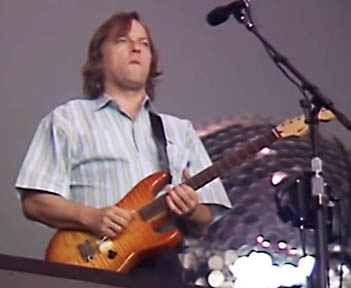
David's custom Charvel San Dimas guitar with EMG-H pickup and SPC presence control
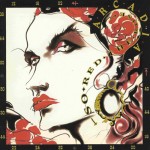
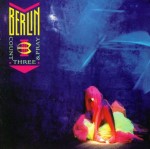
MISSING and THE PROMISE (1986) - Sessions with Arcadia for the So Red the Rose album - Arcadia was a side project made up of members of the band Duran Duran in 1985 (Simon Le Bon, Nick Rhodes, and Roger Taylor). David plays guitar on Missing and The Promise, mostly just coloring the songs, no big guitr solos.
PINK AND VELVET (1986) - Session with Berlin for their Count Three & Pray album. Bob Ezrin, who produced Pink Floyd's The Wall and David's About Face album, was producing this fourth album by the new wave band Berlin. He called his friend David up and asked him to record an epic guitar solo for the song. The chord progression and solo sound very similar to David's Comfortably Numb outro solo. The lead singer for the band, Terri Nunn, said David recorded about 3 hours of guitar solos for the song.
Pink and Velvet was not only a good ballad for the time, but David's guitar solo was hauntingly beautiful and fit the song like a glove. Count Three & Pray was released in October 1987, but the recordings took place in late 1986. As soon as those Berlin sessions were complete Bob Ezrin immediately went to work with David on what would be the next Gilmour/Ezrin project, Pink Floyd's A Momentary Lapse of Reason. The guitar tones on that album are very similar to Gilmour's lead tones on Pink and Velvet.
There is no info available about the gear used in this session. Based on the sound, it's possible this could be David's typical rig for the time - a Boss HM-2 + Mesa/Boogie combo, with some EQ applied from a Boss GE-7, into clean Fender amps. However, David had changed his rig in January of 1986 with the addition of the little Gallien Krueger 250ML amplifier, and was about to change it again for the A Momentary Lapse of Reason sessions that began recording a few months after this Berlin session. The tone on Pink and Velvet sounds more like those AMLOR leads to me, so I think it is more likely that this was recorded with that same rig, or an early version of it. I hear some of the high gain distortion from the Gallien Krueger 250ML amplifier in Pink and Velvet, so this is probably a blend of the 250ML distortion + the disortion from a Boss HM-2 into a Fender amp, either the Fender Concert Combo, or the 1986 Super Champ David used on AMLOR.
The modulation could be the Boss CE-3 chorus David was using in 1986, or the CE-2 he used on AMLOR. The delay sounds like two delays, most likely one of the MXR rack digital delays and a Boss DD-2. There is a short 40-60ms slapback, and a 300ms delay with 2-3 repeats. For the guitar, David had not yet acuired the Steinberger guitar used on AMLOR, so I think he was using his typical recording and live guitars at the time, the red EMG Strat or his Charvel San Dimas with EMG pickup.
David's live rig from this period was used for many of his guest appearances on other artists recordings in 1985-87. He was usually seen with two or four combo amps, rack mounted MXR delays with the Mesa/Boogie stacked in the middle, and a Boss pedal board on top of the rack. This rig varied throughout the 1980s, only changing by the amount of delay and the type modulation used. Sometimes the tone had more mid range, sometimes less. Sometimes more bottom end, other times less.
There are numerous examples of David's stellar playing using this setup throughout the 1980s. Here is a 14 minute medley of different Gilmour guitar solos from this period and into the 1990s, many of which sound like exactly the same setup. Here is the Song List in the order they are heard.
![]() Gilmour Guest Solos from the mid 1980's - early 1990's.
Gilmour Guest Solos from the mid 1980's - early 1990's.
Most of the time David was using the bridge pickup with this setup, but occasionally he used the neck pickup on songs such as Deep in the Blues with Les Paul in 1988. This setup sounds great with either pickup, but I suggest turning the guitar volume down slightly and adding a compressor when using the neck pickup.
Here is one of my favorite Boss HM-2 setups: Boss CS-2 compressor, Boss HM-2, Cornish P-1 (or a Ram's head Big Muff) with sustain dialed off, TC Nova delay at 540ms, ambient reverb delay from a Catalinbread Echorec, into a Fender Twin reverb in the left channel and Yamaha RA-200 rotary speaker cabinet in the right.
![]() Slow Blues - HM-2 / P-1 Combo into Fender Twin and Yamaha RA-200 rotary speaker cabinet
Slow Blues - HM-2 / P-1 Combo into Fender Twin and Yamaha RA-200 rotary speaker cabinet
Kit’s Secret Guitar, Gear, and Music Page
Guitar stuff, gear stuff, soundclips, videos, Gilmour/Pink Floyd stuff, photos and other goodies.
Copyright Kit Rae.
VISIT MY SWORDS, KNIVES and FANTASY ART WEBSITE www.kitrae.net

